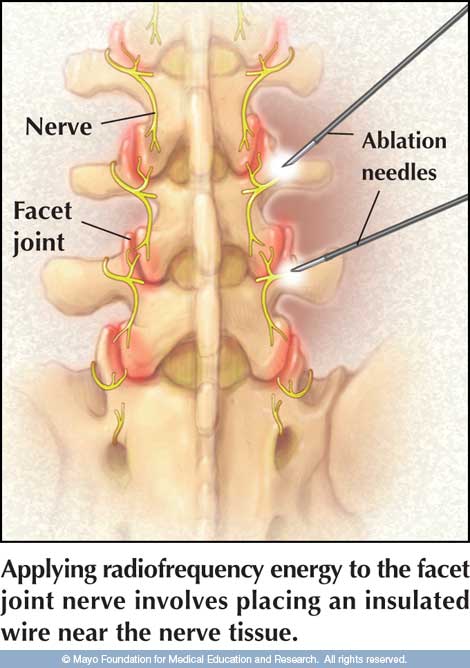Radiofrequency Ablation or Lesioning: Radiofrequency ablation (RFA) is a procedure in which a special machine (i.e. the RFA machine) that uses high temperature “radiofrequency energy” to destroy the small nerve fibers carrying pain signals, thus interrupting those pain signals from reaching the brain, where pain is perceived (i.e. felt by you). RFA will usually give you pain relief for a peroid of months (e.g. 6-9 months), although many patients report relief for up to years. It is only a “semi-permanent” procedue, because the “destroyed” nerves can regenerate over time.
Indications for Radiofrequency Ablation: At SCCPM, Dr. Lee performs radiofrequency ablation for mechanical neck and back pain due to facet pain (i.e. facet joint disease). A variation of RFA, called “Pulsed Radiofrequency Ablatation” is very effectively used for patients suffering from occipital neuralgia (a type of headache), ilioinguinal neuralgia (i.e. groin pain), and other types of neuralgia or neuritis (pain due to abnormal nerve activity).
Technique: At SCCPM, radiofrequency ablations are performed at the surgery center under live x-ray (fluoroscopy) for safety and accuracy. The doctor will usually order IV sedation (i.e. “twilight sleep”) as an option for your comfort. You will be checked in at the surgery center and brought into the operating suite, where you will be greeted by the doctor and registered nurse. After placing monitors (e.g. blood pressure cuff, EKG, pulse oximeter, etc) on you, the nurse will give you IV sedation (if ordered). Afterward, the area of interest will be sterilely prepped, and then the doctor will begin by “numbing” the injection sites with a local anesthetic. Afterward, with the aid of the fluoroscope, Dr. Lee will use RFA needle(s) placed at the sites where the painful nerves of interest are located. To further pinpoint the painful nerves, Dr. Lee will perform a “sensory test” and a “motor test” in which he will use the RFA machine to confirm with you that he has found the correct, painful pain fibers to destroy. Once all confirmations are positive, the RFA machine will be programmed to deliver radiofrequency energy to the tips of the RFA needles, which in turn destroys the painful nerve fibers at high temperatures. After RFA is completed, you will then be transferred to the recovery unit before going home with a family member or friend. You are encouraged to “take it easy” for the rest of the day, and to follow the post-procedure instructions ordered by Dr. Lee. You will be able to resume your normal activities the next day.
Pain Relief Response and Duration:Generally, RFA can lead to longer lasting pain relief than local anesthetic-steroid based nerve blocks. Furthermore, using RFA minimizes the use of steroid medications, which can have side effects. Dr. Lee will generally offer RFA if the nerve blocks are effective but not long lasting for the patient. As mentioned earlier, this is a semi-permanent procedure as the painful nerve fibers can regenerate over time. When this happens, Dr. Lee can repeat the RFA, as with other nerve blocks.

